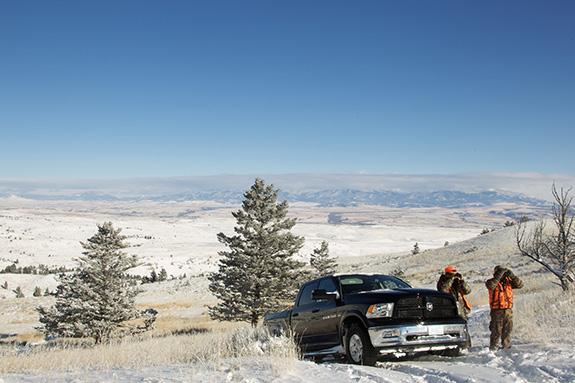Ready Your Rig
Preparing your vehicle for backcountry roads.
Every successful hunt (no matter how you define success) takes place where the animals live—and unless your house sits alongside a huge tract of public land, that means you’re going to have to drive there. That can be an almighty accomplishment in this great (slippery, rocky) state. So, what’s it going to take to get up that Forest Service road to the trailhead? How can you safely get out, should some weather roll in while you’re halfway up the mountain, acquainting yourself with your hunting boots and that set of get-away sticks they attach to? Here are some tips.
Get Tired Out
Nothing cleans mud from its contact surface like a dedicated mud-terrain tire. If you find yourself on a wet fire road with two inches of slop, you’ll be thanking yourself for choosing the more aggressive mud terrains as you breeze past hunters with standard, slicked-over tread on their four-wheeled steeds.
There’s an old saying: “A tall skinny tire provides the best traction off-road.” Over the years, we’ve come to believe that whole-heartedly. Think of a frozen-over dirt road with four inches of snow on top. Now picture how well you can steer a toboggan (wide tire) versus a set of ice skates (narrow tire) on that road. For good traction, you need to find hard earth and being able to cut through that first bit of mush will really help your chances of doing so.
Get Kitted Out
Quality tires will prevent a lot of unpleasant situations, but sometimes a sudden rainstorm or blizzard requires more—especially if your hunting partner didn’t take your advice and is still running on crappy, half-worn tread. Basic self-rescue gear includes a winch or come-along, should you get stuck in place or slide off the road. At the very least, bring a tow-rope, a sturdy shovel, a saw, and a random assortment of hooks, clips, and carabiners for creative problem-solving out there in the middle of nowhere. A pry bar and traction boards can be beneficial, if you have the room to store them.
Get Out Alive
If all is lost and you just can’t get out of the mountains on your own, you’d better be able to make it through the night. Cell-phone coverage can be spotty and you may just have to sit tight and walk out the next day. Pack a duffel with a warm sleeping bag, some extra food and water, a flashlight, and basic first-aid supplies. A small stove and coffee or hot chocolate can do wonders for your morale, too.












